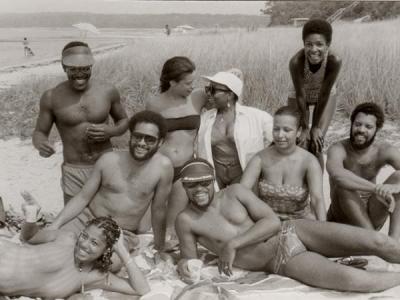One Maxi House Better Than Two Minis?
One Maxi House Better Than Two Minis?
A plan to merge two vacant lots at 20 and 24 West End Road and build a single-family residence in excess of 10,000 square feet, plus a detached garage and accessory structures, was the subject of a lengthy discussion at the East Hampton Village Zoning Board of Appeals on Friday.
The owner, Morad Ghadamian, is seeking variances for an additional 1,431 square feet of ground-floor space and 2,752 more square feet of lot coverage than the zoning code allows. He also applied for a freshwater wetlands permit to install native plantings on the property, which fronts on Georgica Pond.
The attorney Leonard Ackerman, representing Mr. Ghadamian, argued that constructing one overly large house on the merged properties was preferable to having separate residences on the individual parcels. There would be half as many sanitary systems, he said, and less overall lot coverage. In comparison, he said, the requested variances were minimal.
Frank Newbold, the chairman of the Z.B.A., disagreed. The variances sought amount to 16 percent more ground floor area for the house and 15 percent more lot coverage than is permissible, he pointed out. “That is not insubstantial,” he said. “Usually in the village, when it’s a clean slate like this, an empty lot, we are inclined to adhere to the zoning code.”
The building plans call for the installation of a 125-foot buffer between the property and Georgica Pond, as well as a nitrogen-reducing sanitary system, which is not yet required for new construction in the village. Such improvements were commendable, said Mr. Newbold, but “the board would like to see a smaller structure.”
The hearing was adjourned until Nov. 9.
David Gallo, the owner of 94 Apaquogue Road, is seeking a freshwater wetlands permit to excavate phragmites, an invasive plant, from a section of Georgica Pond adjacent to his property. The proposal includes installing a 25-foot buffer area upland of the pond, to prevent runoff from the residence.
Kelly Risotto, a senior ecologist at Land Use Ecological Services, a company that oversees wetland restorations, spoke on Mr. Gallo’s behalf. The phragmites excavation plan is awaiting approval from the East Hampton Town Trustees, she told the board, and the plan for the buffer area has changed somewhat based on the board’s input at its last meeting.
Previously, Billy Hajek, the village planner and a member of East Hampton Town’s water quality technical advisory committee, had advised that native shrubs be installed, to mark the line where the buffer begins and the lawn ends. Jim Grimes, a town trustee, had recommended that the buffer be at least 50 feet wide. Ms. Risotto said the buffer would remain 25 feet wide, but that a staggered row of inkberry shrubs would be used to delineate it, and a 50-foot-wide no-mow zone would be installed landward.
The species of shrub was a sticking point for Mr. Hajek, who said that inkberry was too attractive to deer. Upon closing the hearing, Mr. Newbold said approval of the application would depend on a revised planting plan that meets Mr. Hajek’s approval.
In another continuing hearing, the Hedges Inn asked that the Z.B.A. overturn the village board’s denial of its requests for special-event permits. Christopher Kelley, the inn’s lawyer, said the village had based the decision on an erroneous interpretation of the zoning code. The Hedges is in a residential district, where, Mr. Kelley pointed out, the code allows tents to be used for special events for 21 days per year, and does not distinguish between commercial and residential uses of the property.
“You don’t get different uses because of the type of owner you are,” said Mr. Kelley. He maintained that the inn should be provided the same rights as neighboring homeowners, the East Hampton Historical Society’s Mulford Farm, and St. Luke’s Episcopal Church, which are all allowed to hold outdoor parties. “I’m not aware of any other property that’s been denied a special events permit in the village based on zoning,” he said.
Anthony Pasca, the lawyer for Peter and Patricia Handal, neighbors of the inn who have fought its attempt to hold events such as weddings on its grounds, cited a 2014 amendment to the zoning code in countering Mr. Kelley’s argument. “No variance shall be granted to permit the introduction of any outdoor use, including outdoor dining, to a pre-existing nonconforming commercial use in a residential district,” he read. “They’re claiming this as a right allowance and your code says otherwise.”
Mr. Newbold kept the hearing open to allow Linda Riley, the board’s attorney, who was not present at the meeting, to weigh in on the matter.
Also on Friday, the board announced three decisions.
Joshua Solomon, whose property is at 87 David’s Lane, was granted area variances to install a hot tub 28.1 feet from the rear lot line, where 30 feet is required, and to permit 7,972 square feet of lot coverage where the legally pre-existing coverage is 7,864 square feet.
Gregory and Lisa Wilson of 30 The Circle were granted a 45-square foot area variance to install a concrete pad under a generator and gas meter, an improvement required by National Grid.
Susan Karches of 64 Egypt Lane was granted a freshwater wetlands permit and a variance to install a driveway and landscaping within 81 feet from the edge of wetlands, as well as a cattle guard within 107 feet, where the code does not allow improvements.







